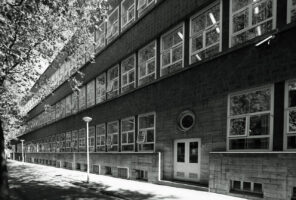Rotterdam Builds in Bricks
Introduction to debate evening Architecture Cases AIR Rotterdam, 16 September 2009
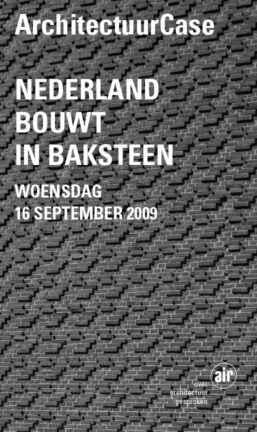 In 1941, the exhibition ‘Netherlands builds in bricks, 1800-1940’ was on show at the then Museum Boijmans. The time and place on the edge of Rotterdam’s devastated inner city due to the 1940 bombing by the Luftwaffe were unfortunately chosen. The event by no means became the great triumph for the brick tradition in Dutch architecture as intended by its creators.
In 1941, the exhibition ‘Netherlands builds in bricks, 1800-1940’ was on show at the then Museum Boijmans. The time and place on the edge of Rotterdam’s devastated inner city due to the 1940 bombing by the Luftwaffe were unfortunately chosen. The event by no means became the great triumph for the brick tradition in Dutch architecture as intended by its creators.
The reconstruction of Rotterdam under the leadership of W.G. Witteveen was already in full swing at the time, and a proud exhibition of Dutch building was not inconvenient for the German occupiers. However, it is going too far to link the event exclusively to the occupation or the reconstruction of Rotterdam. It fits into a Rotterdam architectural culture that manifested itself as early as the 1930s and was vital well into the 1950s. From that period dates an extensive series of buildings characterised by solidity and a strong orientation to their place in the city. It is a phenomenon that now has historical attention. Reflection on the architectural merits of the buildings themselves is also topical: a restoration of the Museum Boijmans-Van Beuningen is imminent, Rotterdam’s new municipal offices are seeking a relationship with the Stadstimmerhuis, and various other buildings from this period are presenting themselves for re-use.
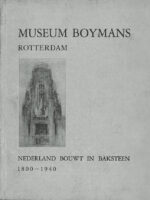 The exhibition The Netherlands Builds in Bricks and the catalogue with the same name were brainchildren of the then museum director Dirk Hannema. With architect Ad van der Steur, he had given shape to a modern equipped museum. In his Boijmans, he would bring old and new together around an internationally renowned collection of paintings from the Golden Age. That hallmark collection was to become a benchmark in Dutch culture. His policy characterised the climate of the crisis years of the 1930s and suited the tastes of the museum’s donors. These were mainly Rotterdam businessmen. In the exhibition, Hannema translated his fondness for seventeenth-century painting into architecture by declaring the historic city centre, characterised by intimacy, picturesqueness and the use of brick, an important source for the Dutch architectural tradition.
The exhibition The Netherlands Builds in Bricks and the catalogue with the same name were brainchildren of the then museum director Dirk Hannema. With architect Ad van der Steur, he had given shape to a modern equipped museum. In his Boijmans, he would bring old and new together around an internationally renowned collection of paintings from the Golden Age. That hallmark collection was to become a benchmark in Dutch culture. His policy characterised the climate of the crisis years of the 1930s and suited the tastes of the museum’s donors. These were mainly Rotterdam businessmen. In the exhibition, Hannema translated his fondness for seventeenth-century painting into architecture by declaring the historic city centre, characterised by intimacy, picturesqueness and the use of brick, an important source for the Dutch architectural tradition.
Metropolitan Rotterdam
Van der Steur was architect at Rotterdam’s municipal works between 1924 and 1931 and chief city architect between 1931 and 1939. He then worked as an independent architect. He designed several large public buildings including the Erasmiaans Gymnasium (on Wytemaweg), the Eye Hospital (Schiedamsesingel), the Twentsche Bank (Blaak) and the police headquarters (on Haagseveer).
His career in Rotterdam largely coincided with Witteveen’s. Witteveen also joined the municipality in 1924, initially as an urban planner. In 1926, he became chief city architect. From the moment Van der Steur took over this position in 1931, Witteveen concentrated in various capacities on the city’s urban development. Witteveen placed it in a regional context. His 1928 General Extension Plan for Greater Rotterdam was given a metropolitan character. It would allow Rotterdam to develop into a city with monumental allure intersected by green parkways. Witteveen made several detailed plans within the General Extension Plan. The Blijdorp district in particular still clearly shows his intentions today.
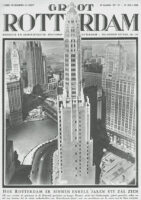
It is tempting to think of Van der Steur’s work as the architectural complement to Witteveen’s metropolitan urban planning ambitions. His buildings also have that urban quality, in addition to possessing an emphatic material presence, mostly derived from the expressive possibilities offered by brick, and working mainly on the rhythm of the façade walls and the accuentation of corners and situational particularities.
Immediately after the bombing, Witteveen drew up the Reconstruction Plan. The plan was elaborated according to a strict architectural plan in which the image was largely determined by means of block maps. Height, depth, number of floors, roof shape, roof pitch and volume were fixed. The designers’ typecasting was far-reaching. The inner city was divided into thirteen supervisory districts. These were separated architectural units with a specific character: J.J.P. Oud supervised the prestigious area around Hofplein, Van der Steur supervised the area between Mariniersweg and Binnenrotte and the young, local architect Kraaijvanger supervised the harbours.
In addition, architect lists were used, arranged in five classes. Modernist architects were initially excluded. The typecasting of the supervisors and their designers was done on the basis of prestige and historical merits. This moved away from the hitherto usual retrospective assessment of plans by the aesthetic planning committee.
Functional city
Although by the end of the occupation a considerable portion of the available building sites had been built on, issued or reserved, Witteveen’s reconstruction project did not get off to a smooth start. The stagnation had to do with the construction ban that came into force in 1942, but also with the comprehensive project organisation, which involved Witteveen, government commissioner Ringers and the German authorities in addition to the clients, architects and supervisors. It is not for nothing that banks were mainly built in the early years. These were vital for the port’s recovery and also had cash at their disposal. In 1944, under the leadership of businessmen Plate and Van der Leeuw, a successful intervention in the planning apparatus was forced after which Witteveen’s former deputy Van Traa was entrusted with the urban planning coordination of the city. Van Traa put an end to the elaborate supervisory structures. A substantial break with Witteveen’s work was that Van Traa no longer presented Rotterdam as a three-dimensional aesthetic construction. Thoroughfares and squares were mainly given a function in traffic management. This is how Hofplein took on its current form. It became a traffic roundabout and lost the built spatial boundaries proposed by Witteveen. Furthermore, developers and their architects had a much stronger grip on the elaboration of building blocks. The present Lijnbaan, for example, was an alternative to the original subdivision at block level and did not emerge from the city design. This explains Lijnbaan’s location behind the thoroughfares like Westersingel, Blaak and Coolsingel.
Van Traa is considered the author of the post-war Basic Plan. Because his tenure virtually coincided with the liberation, his Basic Plan is easily linked to modern Rotterdam as it is still recognisable today, while figures like Witteveen and Van der Steur have become associated with the trauma of the occupation. No doubt this contributed to the problematic nature of the architectural culture portrayed with ‘Netherlands builds in brick’. Only recently has this episode of urban history been accurately described and nuanced by historians such as Wagenaar, Andela, Baeten and Tijhuis.
Brick family
The above sketch is therefore far from complete in historical terms. The trail of Van der Steur, Boijmans, Hannema and Witteveen has been fairly arbitrarily drawn and can easily be extended in time, direction and scale. Until well into the 1950s, a variety of designers created buildings that show affinity through the use of brick in the facade, the restrained expression of facades and volumes, but also through the free use of historical motifs. Now that this generation of buildings is less ideologically charged, the way to an autonomous appreciation of that architecture is open.
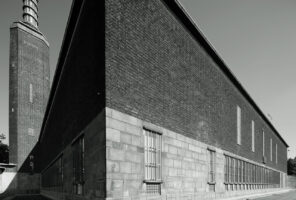
The austere father of this family of traditional brick structures is Van der Steur’s Museum Boijmans, which opened in 1935: it is a public building, deliberately claiming its independent and monumental place in the former Land of Hoboken. It is a unique edifice in a unique place.
A much less conspicuous place in the city are three bank buildings on Blaak. These reflect entirely different urban intentions. They were built immediately after the liberation to designs by the Kraaijvanger brothers (Amsterdam Incassobank, 1946-1950), Van der Steur, Hooijkaas and Van Veen (Twentsche Bank, 1945-1950) and Elffers and Van Nieuwenhuyzen (Nederlandse Handelsmaatschappij, 1941-1950). At first glance, a strong coherence appears due to the box-like design of the buildings, uniform height of the eaves, the similar formats of the windows and the brickwork in the facades. The buildings further have a classical facade construction with carved plinths and eaves, between which a more neutral plane of windows is placed.
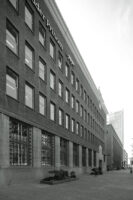
The asymmetrical location of the entrances is remarkable. The entrance on the corner of the Amsterdam Incasso Bank is as high as the building and marks the corner of the row of buildings and might be perceived as an urban planning detail. The entrances of the other two buildings are excentrically located in the façade. The buildings present themselves as a consistent ensemble on the former inner harbour of the Blaak, which had shortly before been filled in with war debris and was to become a boulevard in the Witteveen Reconstruction Plan. The strict repetition of the windows supports this urban quality. The monumental expression of the ensemble conforms to the urban ambition formulated at a higher scale level.
A closer look reveals a second, more differentiated, layer of imagery arising from the individual handwriting of the architects. The differences in handwriting will have stemmed from the ideosyncracy of the architects. Although each building has a brick type that varies in tone and texture and the brick setting and joints also vary, the brick is always red in colour. Van der Steur et al punch standing windows directly into the brick face, while Elffers et al incorporate the windows into an almost Gothic pattern of wall dams and Kraaijvangers provided the windows with natural stone mouldings. In the architectural development, the plinths show hardly any consistency. Architectural differences are particularly drawn out in the interiors. These have rich materials, such as natural stone and copper, and are shaped with highly personalised details.
The Unilever building by architect Mertens is a much more self-contained piece of work, where the heaviness of the brick structures is much more ambiguously rendered. The building stands on the corner of a triangular plot on Rochussenstraat. The sharp corner gives rise to a sculptural treatment around the corner. The building occupies almost an entire building block and conforms to the urban character of Rochussenstraat by means of its repetitive structures. The long facades consist of ribbon windows and bands of brick. In all facades, the bricks are consistently laid in a decorative pattern. Here, the brick is bricked on its edge. The brickwork is displayed as a thin cladding shell. The masonry piers between the ribbon windows are flatly detailed and contribute to the membranous appearance of the glass. In contrast, a heavy stone plinth has been made, forming higher portals at the entrances, where it contrasts with the fleece-like façade strips.

An example of residential architecture in the family series is the block of runup staircase dwellings and commercial spaces by the architects Lockhorst and Overeijnder on Witte de Withstraat. Here, too, a quiet, repetitive facade design is used. The runup staircase type supports the image. Glass strips denote the stairwell. The façades of the actual dwellings in between are of brick, with the grouping of windows varying per façade plane. On the ground floor, the commercial premises are framed in various types of natural stone. The segmentation of the façade does justice to the mundane nature of the residential programme on the one hand and fits in with the intimacy of Witte de Withstraat on the other.
Style
In architectural history terms, it is interesting to speculate on the relationship of this familial series to Witteveen’s space-shaping, objectless urbanism and to Hannema’s exhibition at Boijmans. ‘Netherlands builds in brick’ carefully avoids the problem of style. The architectural conventions of the Old Dutch city were linked exclusively to a building material that had been available for centuries. However, getting past the style problem is also crucial in design theoretical terms.
It is again Van der Steur who addressed this. In a short essay in the catalogue, he categorises the use of brick in terms of its constructive significance in a building. He lists how brick can be used architecturally as purely constructive, decorative, as a filling material and as a cladding material, respectively. He maintains a neutral, contemplative tone, but suddenly braces himself for the last category, ‘the old imitation’. As an example, he mentions the ‘various new cafes’ which, in his view, bear witness to romanticism. In other words, Van der Steur makes an attempt to place the design with brick in a historical line, then brings down the use of the material to sharp tectonic choices and finally argues for its contemporary incorporation. Some pragmatism will not have been alien to Van der Steur as a city architect. His accurate consideration of brick constructions and their manufacturing processes opens the way to a considered approach to the major building flows in the Rotterdam city with conventional techniques without style dictates. Precisely this agility is the most important shared quality of the Rotterdam family series.
Adaptive ability
What is the condition of these buildings today? The banks at Blaak appear to be suitable for new uses. The Unilever building has also undergone major changes inside. The window frames have been replaced by aluminium profiles. Of some buildings, such as Van der Steur’s Central Public Health Building (Schiedamsedijk), the windows have been replaced by white PVC profiles. Van der Steur’s Maritime Museum was demolished, while his police station was extensively remodelled, extended and signed by city architect Maarten Struis (one of his successors) in 1998. The Museum Boijmans-Van Beuningen has been extended several times and will soon be restored again.

It will have to be seen how this piece of Rotterdam architectural culture will be appreciated in the future. The future will reveal the adaptive capacity of this brick family.
Download map of Rotterdam with examples of brick buildings (pdf)
Literature
Koos Bosma en Cor Wagenaar (red.), Een geruisloze doorbraak, de geschiedenis van architectuur en stedebouw tijdens de bezetting en de wederopbouw van Nederland, NAi Uitgevers, Rotterdam 1995
Martin Aarts (red), Vijftig jaar wederopbouw Rotterdam, Uitgeverij 010, Rotterdam 1995
Gerrie Andela en Cor Wagenaar (red), Een stad voor het leven, wederopbouw Rotterdam 1940-1965, Uitgeverij De Hef, Rotterdam 1995
Albert Gielen, Ad van der Steur (1893-1953), BONAS, Rotterdam 2002
Noor Mens, W.G. Witteveen en Rotterdam, Uitgeverij 010, Rotterdam 2007
© Photography Jannes Linders, Rotterdam



